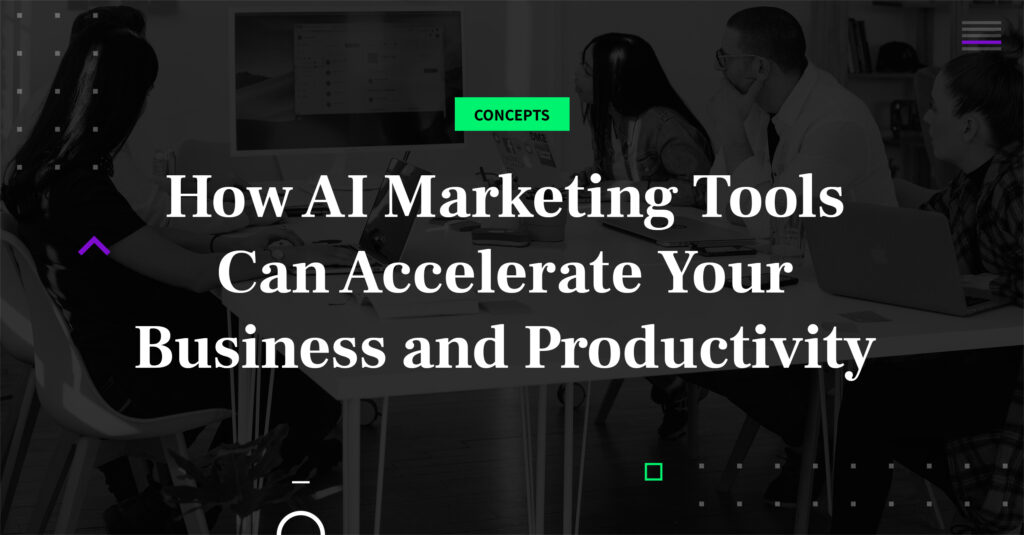Over 50% of businesses report that their business has adopted artificial intelligence (AI) in at least one business function. It’s a matter of time until that number hits a virtual 100%.
Don’t believe us? In this blog post, we address this game-changing emerging field. We include the benefits of AI tools, popular examples to consider, and limitations to be aware of. Keep reading to become a believer.
What Are AI Tools?
AI tools are technology platforms that use the power of artificial intelligence to analyze large amounts of data. This allows AI to recognize patterns, adopt natural language, and learn via machine.
Human intelligence is limited to human speed and the hours that humans have in a day. However, AI uses computers and algorithms to do things at speeds that humans cannot.
For example, marketers can use AI tools to help connect the dots between mass amounts of information that would otherwise take countless hours to get through. With the power of machines, AI tools can examine such volumes of information in a fraction of the time. It can also synthesize important takeaways, and make recommendations for marketers to act upon.
Regardless of your industry, AI tools can help you analyze data to make smarter decisions. You can also automate processes to save time, and replicate manual steps so you can scale faster.
Benefits of AI Tools
Consider a few of the most prominent benefits of AI tools.
Make Smarter Decisions
AI tools help marketers make smarter decisions by analyzing data and making suggestions.
For example, AI tools may analyze sales conversations to identify key terms, topics, and phrasings that lead to the most sales. Now, you can integrate those insights into your conversations going forward. While it would take a single person hours to play back every sales conversation (and would nearly be impossible or very rudimentary to identify the things that make an impact), AI can easily scan for those patterns, succinctly point them out, and enable sales teams to adapt their strategies accordingly.
This is the case with AI tool Adobe Analytics. It turns massive amounts of data into insights upon which businesses can act. Adobe Analytics gathers data across various channels that consumers use, from wearables to laptops to mobile phones to smart home devices and even physical store locations. Adobe helps businesses integrate data from all of these channels. Then, it analyzes the data in real time to better understand consumer behavior.
Improve Productivity
AI tools also help marketers improve productivity by automating manual processes.
For example, AI tools may produce SEO briefs for marketing teams. So, instead of an SEO strategist having to manually sort through competitor posts, identify which keywords to feature in an article, and deliver instructions to a writer, AI can automate the entire process. In one fell swoop, an AI tool can scan through the top posts on the internet, suggest the ideal article length, note which keywords to include, and identify other variables that can help you write the best-ranking post on the internet.
This is the case with MarketMuse, an AI-powered content research, intelligence, and SEO-writing software. Using MarketMuse, you can use AI to analyze your current webpages, compare how they perform against competitors, automate content research, and recommend topics to write about in order to drive the highest ROI for a business.
Scale Faster
Another way in which AI tools help marketers is by enabling them to scale faster.
For example, imagine an A-list actor heading into the recording studio to record thousands of permutations for radio spots across the country. Previously, that actor would have to spend hours in a recording studio making one-word changes for various cities—and that’s before you factor in language, dialects, and accents. With AI tools, software could render that actor’s likeness into thousands of permutations, without the actor having to manually record every iteration themselves. This enables the actor to spend their time and talents where they’re most needed, and frees up media companies to move faster.
This is the case with WellSaid Labs, an AI tool for voiceovers. Using AI, WellSaid Labs has created natural-sounding Voice Avatars with different tones, accents, and voices. Businesses can simply upload a script to the platform, then render text to speech in moments. What used to take voice actors or advertising agencies hundreds of hours to fine-tune in a recording studio and post-production room can now take minutes through this AI tool.
Examples of AI Marketing Tools
In addition to the examples mentioned above, there are a few other categories and examples of AI marketing tools. Some of the top ones include:
Chatbots
Chatbots are interactive marketing tools that help businesses answer consumer questions about topics like product inventory, prices, related products, and customer service issues.
One of the top chatbots is ManyChat. It helps automate interactive conversations across Instagram direct messages, Facebook Messenger, and SMS messaging.
Experts estimate that chatbots can save businesses 30% on customer support costs. According to Juniper Networks, the adoption of chatbots across retail, banking, and healthcare sectors will save businesses $11 billion annually by 2023, or roughly 2.5 billion customer service hours.
Data Analysis
AI data analysis tools help businesses make sense of massive amounts of data. They also analyze patterns, consumer behaviors, and metrics to determine notable trends.
One of the top AI data analysis tools is Google Analytics Intelligence, where Google Analytics users can ask a question in natural language, such as, “Which channel had the highest goal conversion rate?” And then Google’s machine-learning algorithm instantly provides an answer. The tool can also provide other actionable insights like which landing pages perform best, or how to predict conversion rates.
Or consider Crayon, an AI tool that helps businesses determine what their competitors are doing on the internet. It can track more than 100 data types such as product and pricing changes, marketing campaign launches, customer and employee reviews, and more.
Content Generation
AI content generation tools help companies produce, edit, and improve their content.
For example, jasper.ai (formerly known as Jarvis) generates marketing copy for social media, blog posts, websites, and other content channels. Informed by the world’s top SEO and direct marketing experts, the AI tool can create content that ranks for SEO. It can also translate copy into 25 languages and create multiple variations to test in order to improve return on ad spend.
Another popular example is Grammarly. This online and app-based writing assistant checks grammar and spelling across online platforms, from browser tabs to Google Docs to web forms. Grammar isn’t just another version of rudimentary Spellcheck; rather, it’s an AI tool that infers if phrases actually make sense, sound grammatically correct, and what the tone is.
Read More: Sequoia List of Leaders in Generative AI Tools
Buyer Beware: Limitations of AI Tools
With all of these benefits, there are some drawbacks. When should you NOT use AI?
For one, AI isn’t meant to REPLACE human ingenuity; it’s meant to partner with it. In many cases, you still need a human lens to check for quality control or nuances that AI just can’t catch. For example, in the case of Grammarly, a suggestion may technically be correct, but won’t sound right to the human ear. Only humans can know the difference (so far).
Additionally, AI can’t replace some aspects of human conversation. Chatbots can provide quick answers to questions that consumers commonly ask. But in some cases or contexts, you still need humans to help other humans get the answers they’re looking for. One example would be a health hotline. Someone may need a compassionate human ear to walk them through a sensitive topic. Or when people call in with a unique customer service question. They may need a human to help them troubleshoot something that a chatbot isn’t equipped to answer.
__
While AI may never fully replace human ingenuity, when AI is properly used, it can accelerate, improve upon, and simplify human tasks. Whether you’re using AI to create content, analyze data, inform strategic decisions, or understand buyers, AI is here to help you go further, faster.
Our only question to you is: which tool are you going to start using first?




